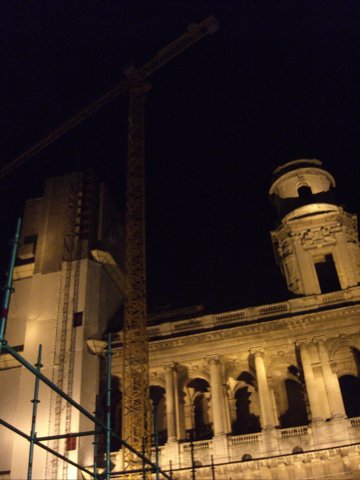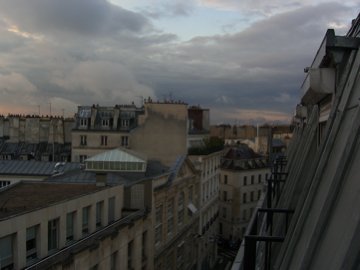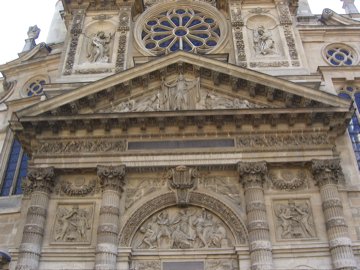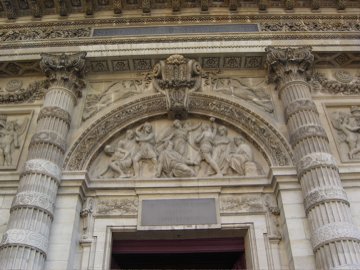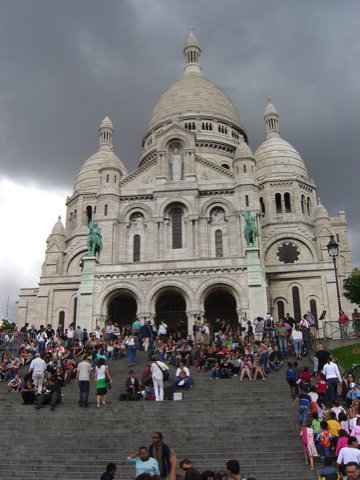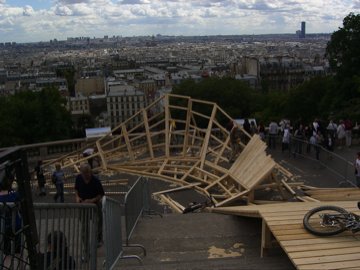OK, I won’t ever do this again, but:
Got up at 5 a.m. to get ready to go to the airport for a 10:15 a.m. flight. The easiest way to get there would have been a 60 euro cab ride — that’s about 80 bucks — but the nice clerk at the hotel found yesterday that no cab company had a car big enough to take my bike box. So that necessitated hauling my unforgivably heavy suitcase, with rollers, and my inconveniently piece-o’-pie-shaped bike box (visual aids will be provided) the quarter-mile or so to the nearest regional train (RER) stop, across the street from the Luxembourg Gardens.
I’ve found Paris in August to be a city that’s late to bed and late to rise, so I knew I could probably haul my luggage right up the middle of my hotel’s little street; after that, the wide sidewalks on the Rue de Virgiraud would suffice. I knew I could pull the two pieces at the same time because I did it when I arrived here 10 days ago; then, however, I had a nice convenient bus ride from the airport, and my bike box rode in a truck with those of all the other PBP types.
I went downstairs from my seventh floor room in the hotel’s tiny elevator, just big enough for me and my suitcase. I paid my bill, pulled my suitcase out to a likely place on the curb, then wrestled my extra-large piece o’ pie out to the street. I lined everything up and started pulling. At the top of the street, the Rue Casimir Delavigne, is the beautifully restored Theatre Odeon. A stationwagon taxi drove a slow circle around the Place de Odeon, and I hoped the driver would see an easy fare and stop. But he didn’t. I continued up to the deserted main street, leaving the bike box behind when I encountered an obstacle, then leaving the suitcase and retrieving the bike. That’s how I got down the multiple flights of stairs into the Luxembourg RER station, where I bought a ticket to Aeroport Charles de Gaulle.
The fare gate was equipped with a door to admit passenger with luggage, but it was locked. I stood contemplating what it would take to lift everything over the gates when a door opened next to the ticket agent’s office and a tall, neatly dressed and vaguely Yves Montand-ish personage appeared. He was going to open the gate so I could take my suitcase through. Then he saw the bike box.
“What is it?” he said, in English.
“My bike.”
“No.
“But. …”
“No. It can’t go. It’s too big.”
“But I brought it on the train from St. Quentin yesterday” — an irrelevant fact even though the St. Quentin train was also on the RER.
“No. It is forbidden.” I had the feeling that was one of Yves’s most used phrases in English.
I had no choice but to plead. I mentioned the fact my flight was leaving today, that I had to get home. I said “please” several times, and the desperation in my tone was not an act. In the back of my mind I was thinking that I’d already been told that a taxi wouldn’t carry the box and that a van shuttle was out of the question because the box was too big for that, too. How would I ever get this thing to the airport if this guy didn’t relent?
Yves didn’t face me directly as I tried to cajole him. He looked at the dark ticket window. I heard him say, “It’s not fair.” Then I saw that Yves was looking at a younger guy in the ticket office; he said something to his younger colleague, who shrugged his shoulders. Finally, he said, “OK. But if you have a problem. …” “Yes — it’s my problem,” I said. Yves opened the gate, and I hustled my stuff down the stairs to the platform. The rest of the trip to the airport was without incident. (If you happen to travel to Paris, the RER trip into the center of the city costs 8.20 euros and is well worth it; just don’t make the trip with an oversize piece o’ pie bike box).
But then there was the airport. As I expected, I had to do the same routine there that I had at the train station: carry one thing up an escalator or stairs, then go back for the other. Several times I had to leave my suitcase unattended. During one of my back-and-forth trips, when I’d left the suitcase at an elevator, I noticed three soldiers, two men and a woman, wearing combat fatigues and carrying automatic rifles. I rode up the escalator behind the woman, who stood facing backward down the escalator with her rifle carried at the ready. It was a little unnerving. The three soldiers got off ahead of me and very casually began walking in the same direction as my suitcase, about 30 meters away. Very casually, they stopped to take a look at it. Unattended luggage. A bag big enough to take out a good piece of the terminal if it were packed by unfriendly travelers. Oh, crap.
“It’s mine,” I said. They turned and looked at me. I wasn’t even trying to communicate in French at this point, and I think that and my hapless appearance suggested that I was on the level as far as the bag was concerned. They motioned I could take the suitcase and go, and I treated them to a demonstration of my dual bag-hauling trick. At the end of the hallway, I reached a point where I had to go up a short escalator to the departure hall. Once more up with the suitcase, leaving the bike box behind. When I returned less than a minute later, three new soldiers were gathering around the bike box. I came back down the escalator, and one of the three said “what is it?” “Mon velo,” I said, a piece of French I was ready with. To my relief, they believed me, and told me to take it up on the elevator. I pointed up the stairs to my suitcase and said, “That’s mine, too.” Nevertheless, when I got up there a couple minutes later, two of the soldiers were regarding it with apparent suspicion. “Votre valise?” one asked when I came up. “Oui,” I said. She motioned for me to go, and I did the two-bag stunt again.
I finally made it to the check-in line and handed over both suitcase and bike box. Now all I have to do is get that stuff through customs at home.
[And now, officially … back on home soil. All my luggage made it. Good to be back!]
Technorati Tags: france, paris, travel
Like this:
Like Loading...

